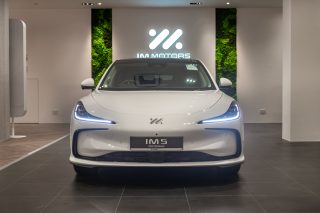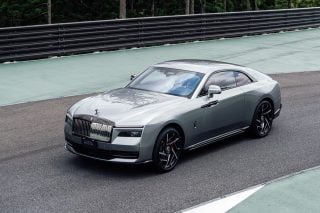
Pointed in the correct design direction is the Volkswagen Golf Cabriolet – prettier than the Volkswagen Eos and more unisex than the Volkswagen Beetle.
The Volkswagen Golf is like the sliced bread of the hatchback world. You can have it white (no-frills 1.2-litre), wholemeal (TDI and BlueMotion) or toasted (GTI and R).
Now, the VW bakery has removed the crust from its bread-and-butter model to create the steaming hot Volkswagen Golf Cabriolet.

You don’t have to be a regular golfer to appreciate this cabin’s ergonomics, equipment and “hairdryer” appeal.
It has been nine years since the last open-air Volkswagen Golf, derived from the Mark 3 model. In 2002 when the Golf cabrio was retired, the “breezier” version of the New Beetle made its debut, soaking up some of the sunlight that shone on the topless Golf.
Three years later in 2005, the also Golf-based Eos entered the scene, sporting a fancy five-piece hard-top with a unique integral sunroof. The car was recently facelifted.

Does the arrival of the Mark 6 Golf soft-top make the Eos redundant? Not quite, because of its solid steel lid (still a distinct selling point), slightly bigger size, significantly higher price and many more horses under the bonnet as standard.
Unless they start producing a full-blown GTI cabrio, which already exists as a teaser concept, the Eos should be sitting safely in the VW showroom.

Sitting pretty on the road is the newly chopped Golf. The hatchback is handsome in its own understated manner, so the (re)designers had a good template to work with.
They sharpened the windscreen angle and lowered the now-fabric roof line, while the rear deck area has become a semi-notchback in order to fit the hood and all.

Of course, the Golf’s canopy is nowhere as sophisticated or as well-insulated as that on its distant relative, the Continental GTC (see Pg 44). But the electro-mechanical, fully automatic top closes tight and opens in a jiffy, taking just nine seconds to do its thing.
Deployment takes a little longer – 11 seconds – but you can operate the roof at speeds of up to 30km/h, which is welcome in the freaky weather Singapore has been experiencing recently.

Just 9 seconds to stash the top and 11 to raise it – this convertible converts quickly.
Downsides? There is a hard thump when the soft-top unlatches from the windscreen header, and the exposed canvas collects water stains easily.
Just clean it regularly, I guess. There is plenty of room in the boot for cleaners, microfibre towels and a few buckets, with the 250-litre cargo hold untouched by the stowed roof.

The windbreaker (in its own carrier) takes up some space inside, so you can leave it at home until that Malaysia driving trip, which will need that anti-draught device when you and your companion are belting along at 150km/h “au naturel”.
Holidaymakers will also appreciate this convertible’s quick-release, split-fold seat-backs, although their load-through aperture is limited by the structural turrets on either side.

Volkswagen Golf Cabrio has a useful 45 litres more boot space than the Volkswagen Eos, the “other” Golf convertible.
Strategic body reinforcements are a given, with Volkswagen claiming top-notch torsional rigidity for its new Golf derivative. Indeed, with the roof up, it rides uncannily like a normal Golf hatch, albeit one that lets in a little more noise from the traffic and tarmac.
The suspension is fairly pliant and the rear view mirror doesn’t jiggle (which would indicate chassis flex) over poor road surfaces. The handling is less tidy than that of your everyday Golf but it is nothing to worry about, especially if you are a boulevard cruiser motorist.

Cruising in comfort are the front occupants, with the rear passengers a bit less comfortable. Headroom is superb with the roof up and infinite with the roof down, rear legroom is decent, and the driver enjoys excellent visibility when in the car’s coupe configuration (thanks to the “windowy” cabin).
Interior climate control works well, not only in terms of air-con performance but also in the management of “topless” wind turbulence.

The overhead roll hoop of the classic Golf convertible is obviously no more, with the latest model employing steel bars ready to shoot up in a split second (0.25 of a second, to be exact) to protect the occupants in a roll-over accident. Another safety feature is the side airbags housed in the lateral sections of the front seat-backs.
Strangely enough, in the back, the left seat seems more spacious and less offset than the right seat. Maybe it has something to do with the fuel nozzle, which resides in the starboard side of the vehicle.

The fuel line leads to the familiar Twincharger 1.4-litre, which develops a healthy 160bhp and 240Nm, the latter available from low down in the rev range. Seven-speed DSG performs the gearchanges.
Despite the weight penalty of the Golf Cabrio, it is less than half a second slower than the similarly engined Golf Sport in the century sprint. Do it with the top down and the cabriolet feels one and a half seconds faster.
It is faster still on the local sales floor – attracting 40 orders at the launch, with another 40 in the weeks after.

Thankfully, the Volkswagen Golf Cabriolet doesn’t look anything like the glam pram that is the Audi A3 Cabriolet.
These buyers are getting a well-priced four-seater soft-top that is less sporty than the Eos but more honest, not as cute as the Beetle Convertible but more gender-neutral, and less prestigious than the Audi A3 Cabriolet but more practical.
Simply put, the new Golf Cabriolet is a very complete alfresco package.
Volkswgaen Golf Cabriolet 1.4 (A)
ENGINE 1390cc, 16-valves, inline-4, turbo-supercharged
MAX POWER 160bhp at 5800rpm
MAX TORQUE 240Nm at 1500-4500rpm
GEARBOX 7-speed dual-clutch with manual select
0-100KM/H 8.4 seconds
TOP SPEED 216km/h
CONSUMPTION 15.8km/L (combined)
PRICE INCL. COE $156,300 (as of December 2011)
Check out the Volkswagen Golf
Check out the Volkswagen Beetle Cabriolet
Group Test: New Volkwagen Beetle Cabriolet 1.2 vs Old Volkswagen Beetle Cabriolet 2.0
Group Test: Peugeot 308 CC vs Volkswagen Golf Cabriolet vs Renault Megane CC












